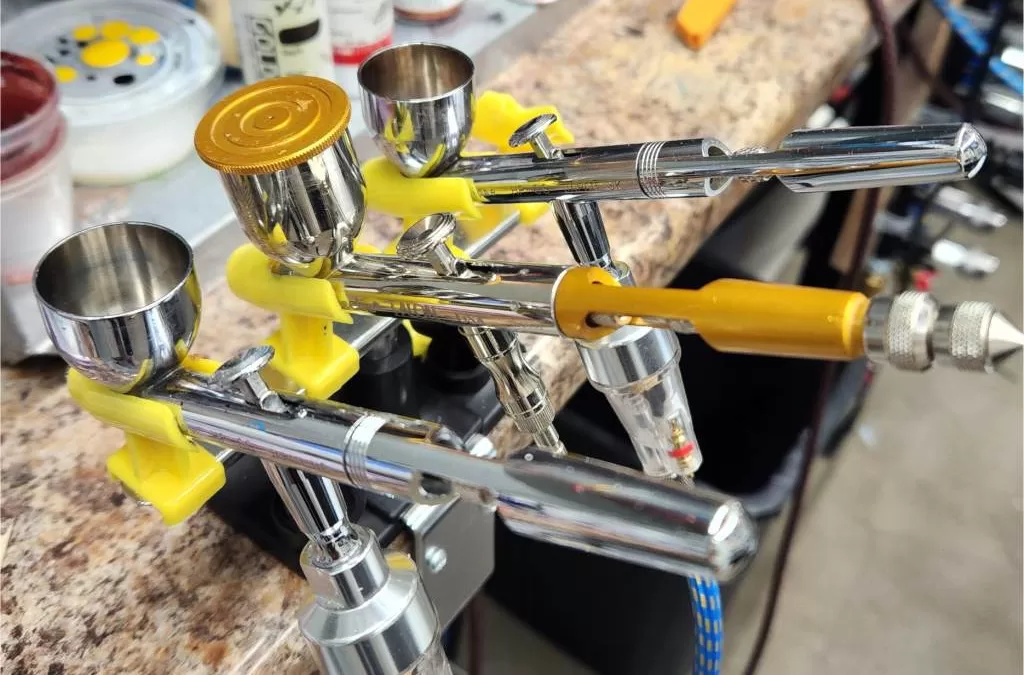Airbrushing is a versatile and artistic technique that allows for intricate details and stunning creations. However, like any creative process involving tools and materials, airbrushing requires careful attention to safety. Whether you’re a beginner or a seasoned artist, understanding and practicing airbrush safety measures is crucial to ensure both your well-being and the quality of your work. In this article, we’ll explore some Top Tips. Please note that this post is not a comprehensive list of how to stay safe while airbrushing. It is your responsibil
Protective Gear: Your First Line of Defense
1. Respirator or Mask: Wear a respirator or mask that is specifically designed for spray painting or airbrushing. This helps protect your lungs from inhaling potentially harmful airborne particles or fumes from paints and solvents.
2. Safety Glasses or Goggles: Shield your eyes from overspray, paint splatters, or accidental spills by wearing safety glasses or goggles. These protective eyewear options should have proper ventilation to prevent fogging.
3. Gloves: Disposable nitrile gloves are an excellent choice to protect your hands from direct contact with paints, solvents, and cleaning agents.
Work Area Precautions
1. Ventilation: Always work in a well-ventilated area to minimize the buildup of fumes and airborne particles. If working indoors, consider using an exhaust fan or open windows and doors to maintain fresh air circulation.
2. Air Quality: If you’re working with solvent-based paints, consider investing in an air purifier with a HEPA filter to further improve the air quality in your workspace.
3. Avoid Eating and Drinking: Refrain from eating, drinking, or smoking while airbrushing. This prevents accidental ingestion of paint particles or fumes.
Paints and Solvents
1. Use Low-VOC Paints: Opt for water-based or low-VOC (volatile organic compounds) paints whenever possible. These options release fewer harmful fumes into the air.
2. Proper Storage: Store paints and solvents in a cool and well-ventilated area, away from direct sunlight and heat sources. Ensure that lids are tightly closed to prevent evaporation and spillage.
Equipment Safety
1. Maintenance: Regularly clean and maintain your airbrush to prevent clogs and ensure smooth operation. Follow the manufacturer’s instructions for disassembly and cleaning.
2. Avoid Over-Pressurizing: Do not exceed the recommended air pressure for your airbrush. Over-pressurizing can damage the airbrush and lead to accidents.
3. Check for Leaks: Before starting your project, check for any air or paint leaks in your airbrush, hose, and connections. Leaks can lead to inconsistent spray patterns and wasted paint.
Cleaning and Disposal
1. Clean Responsibly: Use designated cleaning agents for your airbrush and cleaning tools. Dispose of used cleaning solutions and materials according to local regulations.
2. Recycling and Disposal: Dispose of empty paint containers, solvent bottles, and other hazardous waste materials in accordance with your local hazardous waste disposal guidelines.
Emergency Preparedness
1. First Aid Kit: Keep a well-stocked first aid kit in your workspace, containing items such as bandages, antiseptic wipes, and eyewash solution.
2. Emergency Numbers: Have emergency contact numbers, including poison control and medical facilities, readily available.
Airbrush safety is not only a matter of personal well-being but also an essential aspect of producing high-quality art. By adhering to these guidelines and incorporating safety practices into your airbrushing routine, you’ll create an environment that supports your creativity while minimizing risks. Remember, safe airbrushing practices enhance your skills, protect your health, and ensure a rewarding and enjoyable artistic journey.

